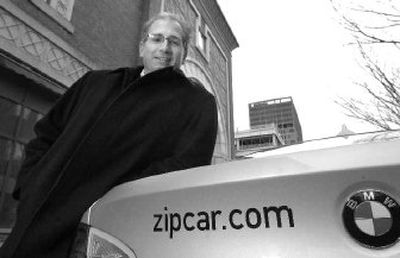A vision of sharing

CAMBRIDGE, Mass. — After nearly seven years of getting strangers to rent cars for a few hours at a time, Zipcar Inc. believes it has the know-how to leap beyond its customer base of tech-savvy 20- and 30-somethings in big U.S. cities.
The car-sharing service plans to announce today that it’s revamping its reservation and fleet management systems — moves Zipcar is taking to support expansion into Europe and other new markets beyond the 13 states and Canadian provinces where it now operates.
It’s also increasingly stationing cars outside cities’ dense centers, hoping to reach prospective customers on the periphery.
“This is all about mainstreaming,” Scott Griffith, chief executive of Cambridge-based Zipcar, said in an interview.
Car-sharing remains a niche phenomenon in a country with more than 200 million vehicles. The company counts 85,000 members who pay fees starting at $7.50 per hour and $56 per day to book vehicles ranging from Mini Coopers to sport utility vehicles parked in urban neighborhoods.
The Cambridge-based company’s only sizable rival, Seattle-based Flexcar, has at least 35,000 members — the company last year stopped disclosing membership growth figures.
Today, Zipcar’s demographic is hardly middle America. More than 90 percent of members have college degrees. Two-thirds are aged 21 to 35, although the company says its demographic is expanding to include more middle-aged customers.
The company’s goal is to attract drivers who may not be tech-savvy, but are receptive to Zipcar as gas and parking costs rise and environmental concerns surrounding car ownership grow.
To accomplish that, Zipcar has recently invested $500,000 a new online reservation system and an upgraded data network.
The reservation process is designed to be simpler, requiring just a few mouse clicks on a single Web browser window to book a car. The network upgrade is supposed to allow Zipcar to more quickly track ever-changing vehicle availability and provide nearly instantaneous reservations.
Zipcar hopes the changes will enable it to station cars in locations that ensure high use, just as airlines juggle planes to fill every seat on a flight.
“At some point, you reach a situation where you have to have a significant number of vehicles on standby, and that increases your fixed costs considerably,” said Steven Szakaly, an economist with the Ann Arbor, Mich.-based Center for Automotive Research. “That’s the hard part as you scale up in size.”
Zipcar members can reserve a vehicle online or over the phone. At the arranged time, the driver enters the vehicle by swiping a coded card over a windshield reader. Keys to start the car are stored inside. When finished, the driver returns the car to the pickup site, typically a private spot in a lot or garage.
Zipcar covers maintenance, insurance and gasoline expenses. Members refill tanks using Zipcar gas cards and are asked to leave at least a quarter-tank.
With 2,500 vehicles, the privately held company is now in San Francisco, Chicago, Toronto, Minneapolis, and Ann Arbor, Mich., after starting out in Boston, New York and Washington. It’s also available on about 30 U.S. college campuses.
Late last year, Zipcar moved into London, an entry point for eventual expansion elsewhere in Europe — a continent where it will face challenges, said Thilo Koslowski, an auto industry analyst with Gartner Inc.